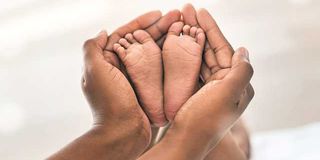Ten years on: Status of maternal healthcare in counties

To uphold the fundamental human right to health, as enshrined in the Constitution, maternal health must remain a top county governments' priority.
What you need to know:
- Across Kenya, significant strides have been made within the health sector, especially in regions that were once marginalised.
- The devolution era has, however, witnessed inadequate funding from the National Treasury and understaffed facilities.
On March 2, 2018, Grace Nyaboke bounced off the walls when a doctor at War Memorial Hospital, a private health facility in Nakuru County, confirmed she was pregnant.
Two weeks later, her joy turned into tears when the child’s father rejected her. At the time, Grace, a primary school teacher by training, was jobless and her boyfriend had promised to take care of her and their child.
“I had made up my mind that I'd keep the child. But my greatest worry was where I’d deliver my child. I really wanted to have my child in a private hospital since I was scared of the public ones. The stories I had heard of nurses beating women in labour or while giving birth were scary,” she says.
“But then I had no money. When the guy rejected me, I went to live with a cousin, still in Nakuru and it was his wife who encouraged me to go to Nakuru Level 5 Hospital for antenatal care clinics.
“I was so amazed by the hospital’s new look. It was clean and organised. I changed my mind about giving birth in a public hospital. Years back, I had accompanied a friend there to get treatment and it was dirty, and people would jump the queue.”
Grace attended all her antenatal clinics at the hospital. She says the nurses were friendly. Nine months later, she had a normal delivery. She describes the nurses—a man and a woman—who handled her as “very nice”.
Also read: A decade on, how devolved Health has fared
During the postnatal care clinics, the nurses patiently listened and responded to her naive questions like asking whether to give the newborn water to drink or not.
“I’d recommend any woman to go to Nakuru Level 5 Hospital, hoping that nothing has changed. I’d be very disappointed if something has changed for the worse,” says Gladys, who later got a job in Kisumu County.
Meanwhile, Isaac Ruto holds mixed feelings about Mariashoni Health Centre in Molo, Nakuru County. Until 2013, the facility was a dispensary offering level 2 services.
But with additional infrastructure, including an inpatient maternity wing, its services have been enhanced to level three.
“Years before, women in labour only had the option of going either to Molo Hospital or to the Provincial General Hospital (Nakuru Level 5 Hospital),” he says.
A major challenge noted in the post-devolution era within the health sector is inadequate funding from the National Treasury and understaffed facilities.
According to the Ministry of Health, a health centre is run by at least one doctor, clinical officers and nurses.
Inadequate staffing
Mr Ruto points to inadequate staffing, a problem affecting smooth delivery of services. “I urge the current governor to hire at least two resident doctors so that one works during the day, and another takes over at night,” he says.
“That way, women won't have to suffer at night looking for delivery services in Molo town, which is kilometres away. In such circumstances, they are forced to use boda boda (motorbikes) as that is the common means of transport here.”
The promulgation of the 2010 Constitution ushered in the devolved healthcare system where each of the 47 counties were handed the health service delivery function, leaving the national government to take care of policy and regulatory functions, as well as national referral hospitals. The reason behind this move was to ensure Kenyans have access to basic healthcare. It brought hope to rural folks through enhanced development and thriving communities.
Mr Ruto's Mariashoni community may have experienced closer access to health services, but service delivery fails to meet their needs.
This mixed regimen of good and bad is not just about Mariashoni Health Centre, but extends to the rest of the counties.
Deaths
There have been cases of women and newborns sharing beds in hospitals managed by counties. Others have died due to what many say is ‘negligence’.
In 2018, then Nairobi governor Mike Sonko, during a random visit following reports of negligence, found 12 infant corpses hidden in boxes and paper bags inside a room at the county’s Pumwani Maternity Hospital.
This prompted him to suspend the hospital management. Since then, the largest public maternity hospital in East Africa, with more than 100 midwives, has more often than not been in the news for the wrong reasons.
In 2019, KTN on Monday ran an exposé of a couple who said their baby was swapped with a dead foetus at the hospital, two years earlier.
In the same year, the family of Nancy Obwaya accused the hospital of negligence after she died under unclear circumstances. She had checked in to deliver her fourth child.
Similarly, questions have been raised over the quality of service delivery at Mama Lucy Kibaki Hospital, also in Nairobi.
In September last year, Maureen Anyango died at the facility a day after she delivered twins. Her family accused the facility of negligence. The matter was taken up by the Senate Standing Committee on Health, which found the hospital responsible for her death.
In April this year, a video of an expectant mother almost delivering at the entrance but denied entry, into the facility, was widely shared on social media platforms.
Later, the hospital management said the patient showed up carrying a dead foetus. The incident prompted Nairobi County leadership to replace members of the hospital’s board.
By the time of going to press, Nairobi County, through the Office of Public Communications, had not cleared the relevant authorities to speak with the Voice on the progress made to improve access to women’s health services in the county’s health facilities.
There have also been cases of women left unattended. In Migori County, for example, Linet Otieno delivered on the floor of Suna West Sub-County Hospital. She was rushed to the hospital at 3am, only to find no nurse on duty.
The list of the bad may be long, nevertheless, there is some good news. The 10 years of devolution have seen counties establish more maternity wings. They also have dedicated child and mother hospitals.
In 2018, Makueni became the first county to unveil an ultramodern mother and child hospital offering aqua-birth services. With aqua birth, women in labour immerse themselves in a pool to ease the pain.
Then governor Kivutha Kibwana, speaking at its launch, said the Makueni Mother and Child Hospital was in line with the county’s priority of ensuring the highest attainable standards of health as envisaged in the Constitution.
“Besides the Mother and Child Hospital, the County Government of Makueni has invested heavily in the improvement of health services, especially maternal and child health,” he said.
In 2022, Kisii unveiled a mother and child hospital at the Kisii Teaching and Referral Hospital, with a sole purpose to reduce maternal and infant mortality. This year, Kakamega opened a new maternity wing at Malava Level 4 County Hospital.
Governor Fernandes Barasa noted during the launch in March that 205 facilities across the county had been earmarked for upgrade. The initiative, he observed, would address maternal and newborn health emergencies, and improve the quality of prenatal and postnatal care.
Mandera, too, has built such facilities at Mandera Referral and Elwak Sub-County hospitals.
In 2005, Kenya's Ministry of Health banned traditional midwifery practices, saying the methods the attendants used risked the lives of the mother and the child.
However, going by the 2022 Kenya Demographic & Health Survey (KDHS) findings, many women are still delivering at home, presumably with the help of traditional birth attendants.
The KDHS data shows that as of last year, 88 per cent of births were delivered at health facilities, out of which 64 per cent were public.
While 11 per cent of births are delivered at home. The data doesn’t tell where the remaining one per cent are delivered.
Home births are most common in the counties of Mandera at 50 per cent, Tana River (48 per cent), Turkana (47 per cent), Wajir (46 per cent), and Samburu (45 per cent).
Contraceptives
The KDHS report also shows family planning among women between the ages of 15 and 49 has increased from 32 per cent in 2003, to 57 per cent in 2022. However, the increase cannot be directly attributed to the counties.
In Mombasa, Maureen Magak, who has interacted with women through her organisation, Lend a Voice Africa, says women prefer seeking family planning services in the Coast General Teaching & Referral Hospital, where contraceptives are not always available.
“The women also say nurses at public hospitals don’t take time to establish the compatibility of the contraceptives they prefer. They say they don’t inform them of how the preferred contraceptive works or its side effects,” she says.
The demographic survey established that among current users of family planning methods, only 62 per cent were informed of what to do if they experienced side effects.
In the eyes of women, counties ought to do much to prevent maternal deaths at labour wards.
“In some counties, women in labour are told to buy a certain drug for inducing labour at Sh5,000, yet they cannot afford even Sh100 for transport. This is so inhuman,” Maureen says.
Infrastructure
Poor infrastructure across the counties have also barred women from accessing salient services. In Marsabit, for example, women are unable to access health services because of poor roads.
Marawato Mifo lost her three-year-old child after an ambulance called from Marsabit Referral Hospital got stuck for three days in the Kambinye area, about 50 kilometres from her village, Kargi.
Marawato cites another case of an expectant mother who miscarried after she failed to get a vehicle to ferry her to Marsabit Referral Hospital, their nearest public health facility.
In Kirinyaga County, Grace Migwi is a happy resident. She says the recently built Matandara dispensary in Mwea Sub-county has saved pregnant rural women from trudge.
In the past, she says, mothers and pregnant women would trek for more than 10 kilometres to access antenatal and postnatal care services at Kimbimbi Sub-County Hospital.
Additional reporting by Jacob Walter and James Murimi; [email protected]



